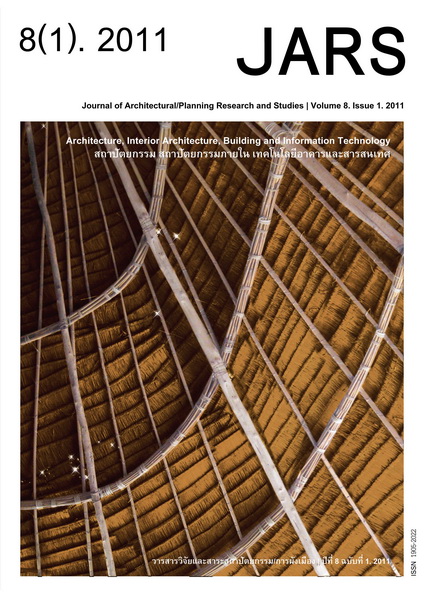Environmentally Friendly Architectural Design Studio: A Studio Based Case Study
Main Article Content
Abstract
The introduction of environmental design strategies into an architectural design studio is not always
an easy task. An experimental design studio at the Faculty of Architecture, Naresuan University, Phitsanulok
encouraged a group of 18 students to design a relatively environmentally friendly office building. The experimental
studio reported here was one of studios in the Special Topics in Architectural Design Studio course,
which allowed students to choose a subject of their interest. The studio’s learning strategies focused on the use
of simple but tangible environmental evaluation activities, such as discussions and workshops, to gauge the
possible health and environmental effects of each design, including its estimated rainwater run-off and solar
efficiency. Through these strategies, the students were able to evaluate the impacts of their design to the
natural environment. The process of measuring and acknowledging these impacts served as a tool for the
students to better themselves by developing lower impact designs in the next draft. As a result, these strategies
were demonstrated to encourage design improvement and served as a useful learning strategy for the teaching
of environmentally friendly design in an architectural studio.
Downloads
Article Details

This work is licensed under a Creative Commons Attribution-NonCommercial-NoDerivatives 4.0 International License.
All material is licensed under the terms of the Creative Commons Attribution 4.0 International (CC-BY-NC-ND 4.0) License, unless otherwise stated. As such, authors are free to share, copy, and redistribute the material in any medium or format. The authors must give appropriate credit, provide a link to the license, and indicate if changes were made. The authors may do so in any reasonable manner, but not in any way that suggests the licensor endorses you or your use. The authors may not use the material for commercial purposes. If the authors remix, transform, or build upon the material, they may not distribute the modified material, unless permission is obtained from JARS. Final, accepted versions of the paper may be posted on third party repositories, provided appropriate acknowledgement to the original source is clearly noted.
References
Department of Alternative Energy Development and Efficiency (DEDE). (2001). Heat and Electricity from Solar Energy. Bangkok, Thailand: Author.
Electric Generating Authority of Thailand (EGAT). (1998). Demonstration Project for Electricity Generation from Photovoltaic Cells on Rooftops, Phase 1, 10 houses. Bangkok, Thailand: Author.
Electric Generating Authority of Thailand (EGAT). (2004). Demonstration Project for Electricity Generation from Photovoltaic Cells on Rooftops, Phase 2, 50 houses. Bangkok, Thailand: Author.
Hengrasmee, S., & Vale, B. (2009). Evolving sustainability capability: A user manual for encouraging moves to a sustainable future. In Building Technology Division, Faculty of Architecture, Kasetsart University (Ed.), Conference Proceeding of iNTA-SEGA 2009: Building Innovation, Technology & Tradition. Produced primarily as a CD-based product.
Hermannsdörfer, I., & Rüb, C. (2005). Solar design: Photovoltaics for old buildings, urban space, landscapes. Berlin: jovis.
Regional Office of Energy Development and Promotion 9. (n.d.). Solar radiation. Retrieved September 12, 2007, from http://www.dede.go.th/dede/index.php?id=428
Thai Meteorological Department (TMD). (n.d.-a.). Meteorological knowledge: Difference of climate. Retrieved June 4, 2007, from http://www.tmd.go.th/info/info.php?FileID=59
Thai Meteorological Department (TMD). (n.d.-b.). Report of monthly temperature and rainfall. Retrieved June 18, 2006, from http://www.tmd.go.th/monthly_report/cur_temp.php
Thai Meteorological Department (TMD). (n.d.-c). Meteorological Knowledge: Rainfall. Retrieved May 19, 2007, from http://www.tmd.go.th/info/info.php?FileID=55


